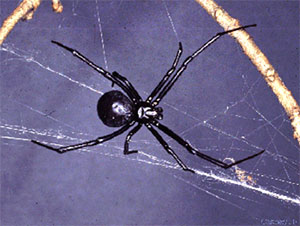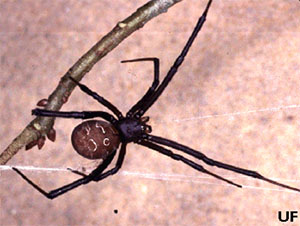Environmental Science Section - Insect and Wildlife
Poisonous Spiders
Introduction
The spiders listed on this page are found on Fort Johnson. Most spider bites are not likely to be dangerous, but medical care and advice should be sought in each case and it is important to save any biting spider so it can be identified.
Widow Spiders
The black widow spider is found throughout the western hemisphere, and is extremely common in the southern United States. The southern black widow and the northern black widow are a shiny, jet-black color. The southern black widow has a red hourglass marking on the underside of the abdomen and another red spot at the tip end of the abdomen. The northern black widow has a row of red spots located in the middle of its back and two reddish triangles resembling an hourglass on the underside of the abdomen. The brown widow spider varies in color from gray to light brown or black. The abdomen has variable markings of black, white, red, and yellow. On the underside of the abdomen the brown widow has an orange or yellowish-red hourglass marking.
The southern black widow is the most widespread widow spider in the southern states and is also found as far north as Massachusetts. It is usually found outdoors in protected places such as in hollows of stumps, discarded building materials, rodent burrows, storm sewers, and under park benches and tables. Around houses, the southern black widow is found in garages, storage sheds, crawl spaces under buildings, furniture, ventilators, and rain spouts. The northern black widow is mainly found in forests in irregular, loosely woven webs three to 20 feet above the ground. The brown widow usually lives on buildings in well-lighted areas.
Like most spiders, the widow spiders are shy and will not bite unless aggravated. All species have a strong venom.. The bite of the black widow is not always felt, but usually feels like a pin prick. The initial pain disappears rapidly leaving a local swelling where two tiny red spots appear. Muscular cramps in the shoulder, thigh, and back usually begin within 15 minutes to three hours. In severe cases, later pain spreads to the abdomen, the blood pressure rises, there is nausea and profuse sweating, and difficulty breathing. Death may result from the venom, depending on the victim's physical condition, age, and location of the bite. However, death seldom occurs if a physician is consulted and treatment is prompt.
If you suspect that a widow spider has bitten you, capture the specimen for identification and immediately consult a physician. For additional information, your doctor may wish to contact your local poison control center.
Southern Black Widow Spider


Latrodectus mactans (Fabricius). The southern black widow spider is glossy black and has a complete hourglass marking on the underside of the abdomen. The northern black widow, L. variolus Walchenaer, has the same general appearance but has two red triangles resembling an hourglass, and a row of red spots on top of the abdomen. The southern black widow is usually found outdoors in protected places, such as under rocks and boards and in and around old buildings.
Brown Widow Spider


Latrodectus geometricus (Fabricius) The brown widow spider varies in color from light gray to light brown to black. The abdomen has variable markings of black, white, red and yellow. The underside of the abdomen has an orange or yellow hourglass. It usually makes its web on buildings in well lighted areas.